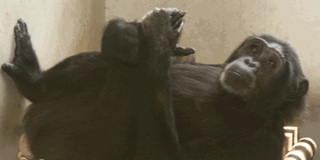Meet Kiri, the haermaphrodite chimpanzee

A chimpanzee lounging in its home at the Uganda Wildlife Education Centre.
What you need to know:
Chimpazees by virtue of what they are, wildlife, are intriguing. But a chimpanzee that is part male, part female, is not just intriguing but also makes one curious.
Tourists and conservationists from various sections of the world are visiting the Uganda Wildlife Educational Centre (Uwec) to see, and carry out research, on the recently rescued 30-year-old haermaphrodite chimpanzee.
The chimpanzee hails from Mpanga Falls, in Kamwenge District from a sandwiched section of Queen Elizabeth National Park that runs from the top of Mpanga Falls to Lake George.
Kiri’s condition
The chimpanzee is called Kiri, a Sri Lankan name that means milk, which was given to him by one of the men, working with the Sri Lankan Company constructing a dam at Mpanga Falls. True to its name, Kiri has an excessive love for milk.
Kiri, believed to be the first discovered haermaphrodite chimpanzee in the world, has both female and male genitalia. Although Kiri has more feminine features, it has testosterone glands, primarily secreted in the testicles of males to play a key role in the development of male reproductive tissues like testis and prostate, as well as promoting secondary sexual characteristics like muscles, bone mass, and the growth of body hair.
“We can’t hurriedly take a decision to operate it and make it either female or male because this is the first case we are getting.
“After enough consultations from some international zoos that are all hearing of it for the first time, we need to carry out enough research,” Uwec Executive Director, James Musinguzi, says.
He says they need to study its feeding habits, response when being integrated, and various other things before they rush to operate.
The Centre spokesperson, Belinda Atim, says Kiri was taken to Uwec on December 27, 2009 at the age of 27, after it had become unruly and turned against the Asians who had found it. However, wildlife experts who rescued it from Queen Elizabeth, say the company working at Mpanga Dam disturbed the peace of the wildlife in the area, with activities like blasting rocks, heavy traffic, and a large presence of humans.
This forced the chimpanzee group away. However, the group left Kiri behind for yet-to-be known reasons.
Atim says the workers at the dam surrendered Kiri to Uwec, when they discovered it was starting to cause trouble by biting people, pulling away guns from the security guards, blocking routes and chasing after people it found along its path.
“We suspect it to have either been thrown out of its group due to its condition or lost its habitat, with the construction of Mpanga Falls,” she adds.
Uwec’s veterinary officer, Noel Arinteireho says they found Kiri with testosterone hormones, 18 times more than other normal female chimpanzees. “We used our vaginal scope and her female private parts looked blind. We now want to carry out an ultra sound scan to find other female reproductive features like fallopian tubes, cervix among other parts,” she said.
Anti-social behaviour
The centre caretakers say Kiri is noisy, bangs the doors, screams often and is very selective with food, possibly, behaviour attributed to long term isolation.
The caretakers recently tried to integrate Kiri in May 2010 and the other chimps accepted it well, but after a few weeks it had to be returned to the animal nursery after it exhibited signs of extreme stress, and suffered a bacterial infection – an indication that it was not used to being with fellow chimps.
Kiri has since recovered and integration will be attempted once again, upon the completion of the baboon exhibit to move the baboons to their new home, and leave their old room for chimpanzee integration.
Dr Arinteireho says the centre has no intentions of breeding Kiri at the moment, and that it may not even conceive, if this is tried. But there have been talks of removing one of the genitalia, once the right time is agreed upon.
Kiri is a stubborn chimpanzee, who loves eating fruits and making a lot of noise, especially when it sees unusual visitors.
It is still being kept under quarantine until it is integrated with other chimpanzees at Uwec, with the hope that it will become as sociable as ordinary chimpanzees are known to be.



